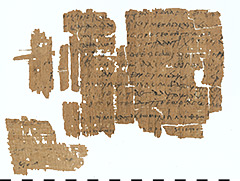P. 8687
Most definitely, you have heard of Christmas, perhaps you often even celebrated it and sang carols while doing so. But what have thorns to do with Christmas? What was it like 1400 years ago? Were there the same religious traditions and topics as today and what did religious hymns look like? Are there any parallels to now and then? You can find out this and much more by looking at a papyrus with two Christian hymns on it, which is in the Berlin Papyrus Collection.
Three fragments of the original papyrus text have survived, whose position to each other is secured due to the text. The papyrus is broken on all sides; thus, no complete line has survived. Both sides were written in Greek. There are two sides, with 12 lines of remnants on the reverse (verso) side and 9 lines of remnants on the front (recto) side. The text on the recto is heavily rubbed and therefore not easy to read. Based on the writing, both texts can be dated to the 7th–8th century.
Two different writers have written the two texts on the papyrus. They begin on the verso with a Christmas hymn, which is written in a rather cursory, right-slanted and irregular script. From the eleventh line on the same page a hymn dedicated to the virgin Mary (theodokion) starts, which is probably continued on the other side of the papyrus. It was written carefully and in a small font. Striking is, that at the end of line 3 on the front page the last letters have been rewritten. The writer obviously used the rest of the ink in his calamus (pen) to write these letters, then picked up the ink and traced the same letters again.
The first is a Christmas hymn. This is indicated by several points that are to be located in the context of the birth of Jesus. For example, the virgin Mary is mentioned (l. 8). A celebration is called for (l. 10). Finally, it speaks of a joy for the world (l. 2) – presumably, because the Son of God now lives on earth. Episodes from the later life of Jesus Christ are mentioned, e.g. his forty-day retreat into the desert, where he resisted the temptations of the devil, which is recorded in the New Testament in the Gospel of Luke (4:2). In the text and its formulations, several parallels can also be found in other biblical texts, especially in the psalms.
Also interesting about this text are numerous markings that can be found over various letters and syllables. These could initially be accents or bookmarks. Presumably, however, this is a musical notation. This can also be recognized by the fact that numerous consonants have been written twice and the words thus orthographically incorrect. Letter doublings are typical for musical notations and indicate the rhythm in which the text was supposed to be sung. Normally, the vowels are duplicated, as for example in another Berlin papyrus with Christian hymns (P 16595) from the same time period. However, in this text the consonants are duplicated. This phenomenon is very rare. The musical notations occur mainly in the first text and less frequently in the second one.
The virginity of Mary, which is mentioned in the text (l. 8), is the main theme of the second text. Here the burning thorn bush from (Book Exodus 3:1–6) is mentioned, which was a metaphor for the virgin birth of Jesus in early Christian art. Just as the thorn bush withstood the fire, Mary remained a virgin even though she had become a mother. There are numerous parallels to other biblical text on this papyrus side as well. Due to its fragmentary state of preservation, the details of the text’s content can no longer be determined. Nevertheless: This text has survived once again on a papyrus in the Vienna collection and can therefore be interpreted with the help of this parallel.
Both texts are interesting examples of the prevalence of hymns in early Christian liturgy and the long continuity of Christian religious traditions to today. The musical notation as indications of the way the hymns were to be recited make this papyrus special despite its poor preservation.



